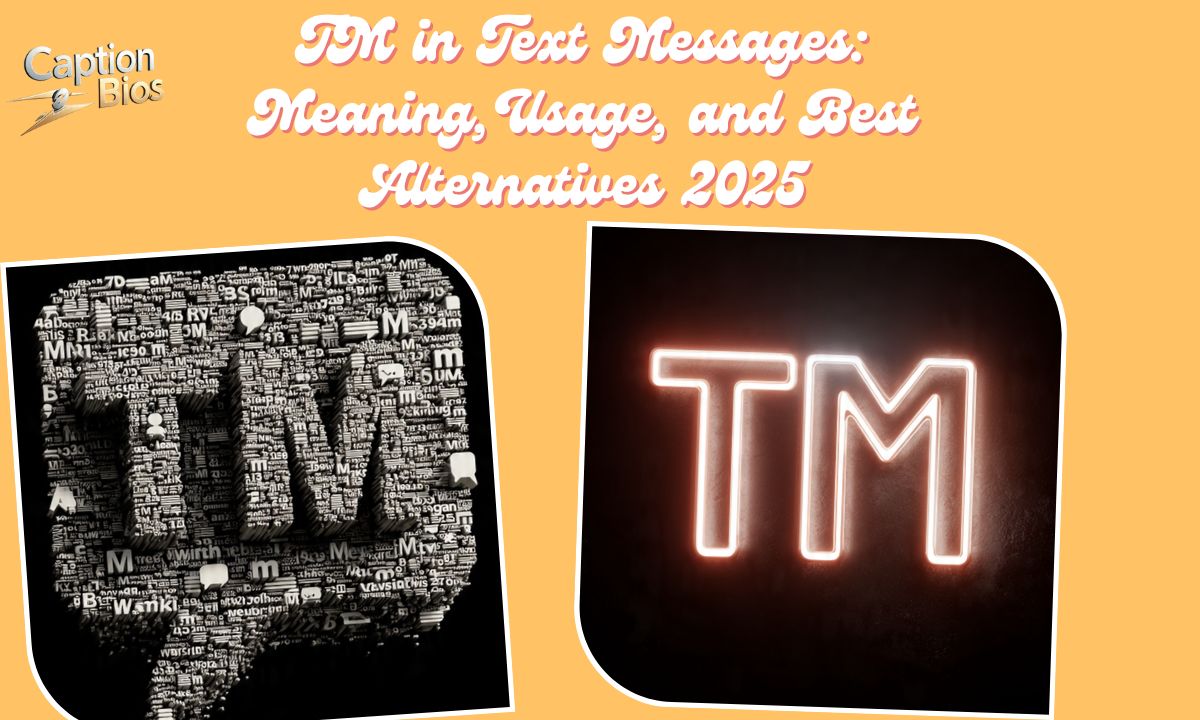TM is a popular abbreviation in text messages that can mean different things depending on the context. Most commonly, it stands for “Text Me” in casual conversations between friends and family.
It can also mean “Trust Me” when giving advice, “Too Much” when something feels overwhelming, or “Trademark” in business settings. While TM is convenient for quick texting, it often causes confusion because people interpret it differently.
What Does TM Stand For in Text?
The abbreviation “TM” is remarkably versatile, carrying multiple meanings that shift dramatically based on context, audience, and communication setting. Understanding these various interpretations is essential for effective digital communication in 2025.
1. Text Me
This is arguably the most popular interpretation among younger demographics and casual texters. When someone types “TM” in a personal conversation, they’re typically asking you to send them a text message later or confirming that they’ll reach out via text.
Example: “I’m in a meeting right now. TM in an hour and we’ll discuss dinner plans.”
This usage dominates platforms like WhatsApp, iMessage, Snapchat, and Instagram DMs, where quick, informal exchanges are the norm.
2. Trademark
In its most formal and legally recognized form, TM stands for “trademark” — a symbol (™) used to indicate that a particular word, phrase, symbol, or design is legally registered or claimed as representing a company or product. This meaning is prevalent in business communications, marketing materials, and legal documents.
Example: “Please ensure all instances of our brand name include the TM symbol: BrightFuture™”
3. Too Much
When emotions run high or situations become overwhelming, “TM” serves as shorthand for “too much.” This interpretation is common in venting sessions, dramatic storytelling, or when expressing that something has crossed acceptable boundaries.
Example: “The amount of homework our professor assigned over spring break is TM!”
4. Trust Me
In persuasive or reassuring contexts, “TM” can mean “trust me.” People use this when trying to convince someone of something or when offering advice they believe will be beneficial.
Example: “You should definitely apply for that position. TM, you’re more qualified than you think.”
5. Tomorrow
Though less common due to potential confusion with other meanings, some people use “TM” as an abbreviation for “tomorrow,” especially when scheduling meetings or making plans.
Example: “Can we reschedule our coffee date to TM morning?”
6. Team Member
In professional settings, particularly within project management software, collaborative platforms, or workplace chat applications, “TM” frequently refers to a “team member.”
Example: “Each TM should submit their progress report by Friday afternoon.”
7. Transcendental Meditation
In wellness and mindfulness communities, “TM” might reference Transcendental Meditation, a specific meditation technique.
Example: “I’ve been practicing TM for six months and it’s completely changed my stress levels.”
Understanding the Tone Behind TM
The tone accompanying “TM” varies significantly based on context, relationship dynamics, and communication platform. Recognizing these tonal nuances prevents misinterpretation and ensures your message lands as intended.
Casual and Playful Tone
In friend groups, family chats, or romantic relationships, “TM” typically carries a light, informal vibe. When used to mean “text me” or “trust me,” it suggests comfort and familiarity between communicators. There’s an implicit understanding that both parties share similar communication styles and interpret abbreviations similarly.
Characteristics:
- Used freely without explanation
- Often paired with emojis or casual language
- Appears in rapid-fire conversations
- Context is usually clear from surrounding messages
Neutral and Professional Tone
When “TM” appears in workplace communications meaning “trademark” or “team member,” the tone becomes neutral and functional. Here, clarity takes precedence over casualness, and the abbreviation serves efficiency rather than intimacy.
Characteristics:
- Appears in structured communications
- Often defined in context or glossaries
- Used consistently across documentation
- Understood within specific organizational frameworks
Emotional and Expressive Tone
When “TM” means “too much,” it often accompanies heightened emotions — frustration, excitement, overwhelm, or exasperation. The tone here is decidedly more dramatic and expressive.
Characteristics:
- Frequently paired with exclamation marks
- Used during venting or storytelling
- Conveys strong feelings about a situation
- May include multiple punctuation marks or emojis
Persuasive and Reassuring Tone
As “trust me,” TM takes on a persuasive quality, attempting to build confidence or reassure the recipient. This usage requires existing rapport, as telling someone to “trust me” in abbreviated form assumes a relationship foundation.
Characteristics:
- Appears in advice-giving contexts
- Used when recommending something
- Conveys confidence and certainty
- May follow personal testimonials
When to Avoid Using TM in Text
Despite its convenience, “TM” can create confusion, appear unprofessional, or lead to misunderstandings in certain situations. Recognizing when to spell things out completely demonstrates communication maturity and consideration for your audience.
1. Professional Emails and Formal Correspondence
Never use casual interpretations of “TM” in job applications, client communications, formal business proposals, or professional introductions. Even if your workplace culture is relatively casual, abbreviations can undermine your credibility.
Why: Professional contexts demand clarity and sophistication. Abbreviations can appear lazy or unprofessional to senior colleagues, clients, or potential employers.
2. Cross-Cultural or International Communications
When texting or messaging with people from different countries or cultural backgrounds, avoid “TM” unless you’re certain they’ll understand your intended meaning. Abbreviations don’t always translate across linguistic or cultural boundaries.
Why: Different cultures have varying levels of comfort with abbreviations, and what’s common in American texting culture may be completely foreign elsewhere.
3. First-Time Conversations or New Relationships
When messaging someone for the first time — whether romantically, professionally, or platonically — stick to complete phrases rather than abbreviations. This shows respect and prevents immediate confusion.
Why: You haven’t established shared communication norms yet. Using abbreviations prematurely can seem presumptuous or create unnecessary obstacles to understanding.
4. Legal or Official Documentation
Even when referring to trademarks, spell out the full term in legal documents, contracts, or official filings. While the ™ symbol is appropriate, the abbreviation “TM” in running text may lack necessary formality.
Why: Legal contexts require absolute clarity with no room for misinterpretation.
5. Sensitive or Serious Conversations
When discussing difficult topics, emotional issues, or serious matters, abbreviations can feel dismissive or inappropriately casual. Take the time to express yourself fully.
Why: Serious conversations deserve full attention and clear communication. Shortcuts can inadvertently minimize the gravity of the discussion.
6. Mixed-Age Group Conversations
In family group chats or community forums where ages range widely, older generations may not recognize common abbreviations that younger people use fluently.
Why: Generational communication styles differ significantly. What’s obvious to a 20-year-old may be incomprehensible to a 60-year-old.
15 Advanced Ways to Say “TM” (Text Me, Trust Me, Too Much, etc.)
Replacing “TM” with more articulate alternatives elevates your communication, reduces ambiguity, and demonstrates linguistic sophistication. Here are 15 polished alternatives organized by meaning.
If “TM” Means “Text Me”:
1. “Send me a message when you’re available.” This phrase works beautifully in both personal and professional contexts. It’s clear, polite, and sets no pressure for immediate response.
2. “Drop me a line later.” Casual yet complete, this expression maintains friendliness while being perfectly understandable to any English speaker.
3. “Ping me once you’ve arrived.” Popular in tech-savvy circles and workplace communications, “ping” has become widely accepted as a friendly way to request contact.
4. “Reach out via text when convenient.” Slightly more formal, this works well for semi-professional relationships or when you want to sound considerate of the other person’s time.
5. “Let me know through text.” Straightforward and clear, this leaves no room for confusion about your preferred communication method.
If “TM” Means “Trust Me”:
6. “I promise you won’t regret this.” This alternative adds warmth and personal investment to your reassurance, making it more convincing than a simple abbreviation.
7. “You can count on my judgment here.” Professional yet reassuring, this works well when offering advice in workplace or serious contexts.
8. “Believe me, this is worth trying.” Natural and conversational, this maintains the persuasive element while being completely clear.
9. “I’m speaking from experience.” This adds credibility by implying you’ve personally tested or experienced what you’re recommending.
10. “Have faith in me on this one.” Perfect for close relationships where trust is already established, this deepens the emotional connection.
If “TM” Means “Too Much”:
11. “This is getting overwhelming.” Honest and direct, this clearly communicates that you’re reaching your limit without sounding overly dramatic.
12. “That’s excessive, don’t you think?” This phrasing invites agreement and validation, making it perfect for venting or seeking commiseration.
13. “I’m reaching my capacity here.” Professional enough for workplace use, this sets boundaries while explaining your state clearly.
14. “This situation has escalated beyond reasonable.” More formal and measured, this works well when discussing serious matters that have gotten out of hand.
15. “I can’t handle any more of this.” Direct and emotionally honest, this clearly establishes your boundaries and current emotional state.
Why Using Alternatives to “TM” Matters
Choosing complete expressions over abbreviations like “TM” offers numerous communication advantages that extend beyond simple clarity.
Enhanced Clarity and Precision
Full phrases eliminate guesswork. When you write “Send me a text when you arrive” instead of “TM when you get here,” there’s zero ambiguity about what you mean. This becomes especially critical in situations where misunderstanding could have real consequences — missed meetings, failed plans, or professional miscommunications.
Professional Credibility
In workplace settings, clear communication signals competence and attention to detail. Professionals who consistently communicate clearly are perceived as more reliable, mature, and promotable. Using complete phrases demonstrates that you value the recipient’s time and understanding enough to communicate precisely.
Cross-Generational Accessibility
Complete expressions bridge generational divides effortlessly. While Gen Z might fluently navigate dozens of abbreviations, older colleagues, family members, or clients may struggle. By choosing clarity, you ensure your message reaches everyone in your audience effectively.
Cultural Inclusivity
In our globalized world, many text conversations occur across cultural and linguistic boundaries. Non-native English speakers or people from different cultural backgrounds may not recognize common English abbreviations. Full phrases make your communication accessible to international audiences.
Emotional Nuance and Tone Control
Complete sentences allow for better emotional expression and tone management. “I promise this will work out” conveys warmth and confidence far more effectively than “TM” ever could. You can adjust your word choice, sentence structure, and emphasis to match your precise emotional intent.
Reduced Misunderstanding and Follow-Up Questions
Clear initial communication saves time by preventing the back-and-forth clarification that often follows ambiguous abbreviations. One well-phrased message beats three exchanges trying to figure out what someone meant.
Common Mistakes People Make with TM
Even experienced digital communicators make errors when using “TM.” Recognizing these common pitfalls helps you avoid them.
Mistake 1: Assuming Universal Understanding
Perhaps the most frequent error is assuming everyone interprets “TM” the same way you do. Even within the same age group or friend circle, people may default to different meanings based on context clues they perceive.
Solution: When in doubt, spell it out. If there’s even a small chance of confusion, use the complete phrase.
Mistake 2: Overusing Abbreviations in Professional Settings
Some people carry their casual texting habits into workplace communications, sprinkling abbreviations throughout emails, Slack messages, or project documentation. This can undermine professional credibility.
Solution: Maintain distinct communication styles for different contexts. Keep abbreviations for truly casual personal chats.
Mistake 3: Using TM Without Establishing Context
Dropping “TM” into a conversation without any contextual clues forces the recipient to guess your meaning, which can lead to confusion or misinterpretation.
Solution: Ensure surrounding sentences provide clear context, or better yet, use the full phrase.
Mistake 4: Mixing Multiple Abbreviations
When messages contain several abbreviations (“TM when you’re ready. TTYL. BTW, did you get my email? LMK ASAP”), they become difficult to parse, especially for less abbreviation-fluent readers.
Solution: Limit abbreviations per message, or eliminate them entirely for clearer communication.
Mistake 5: Using TM in Emotional or Serious Conversations
Abbreviating during heartfelt, difficult, or serious discussions can appear dismissive or inappropriately casual, potentially hurting the other person’s feelings or minimizing important topics.
Solution: Match your communication formality to the conversation’s emotional weight. Serious topics deserve fully spelled-out messages.
Mistake 6: Ignoring Recipient Preferences
Some people explicitly dislike abbreviations or have told you they find them confusing, yet communicators continue using them out of habit.
Solution: Adapt your communication style to your audience. If someone has expressed confusion or dislike of abbreviations, respect that preference.
Contextual Examples: How TM Can Shift Meaning

Seeing “TM” in action across different scenarios illustrates how dramatically context affects interpretation.
Example 1: Casual Friend Conversation (Text Me)
Alex: “Hey, I’m heading to the mall now!”
Jordan: “Cool! TM when you get to the food court.”
Better alternative: “Cool! Text me when you reach the food court.”
Analysis: In this casual friend exchange, “TM” clearly means “text me.” However, the improved version removes any potential confusion and sounds more natural.
Example 2: Business Email (Trademark)
Marketing Director: “Please ensure all instances of our product name include the TM designation.”
Designer: “Understood. I’ll add the ™ symbol to FreshBrew throughout all materials.”
Analysis: In professional contexts, “TM” referring to trademark is standard and appropriate. The designer correctly interprets and implements this request.
Example 3: Venting to a Friend (Too Much)
Sam: “My boss just assigned me three more projects for next week.”
Taylor: “What?? That’s TM! You’re already drowning in work!”
Better alternative: “What?? That’s too much! You’re already drowning in work!”
Analysis: While “TM” works here among friends, the full phrase “too much” better conveys the emotional solidarity Taylor is expressing.
Example 4: Giving Advice (Trust Me)
Maya: “Should I really take that job offer? The commute is pretty long.”
Zoe: “The opportunity is incredible. TM, the commute won’t matter once you see the growth potential.”
Better alternative: “The opportunity is incredible. Trust me, the commute won’t matter once you see the growth potential.”
Analysis: The abbreviated “TM” slightly weakens Zoe’s persuasive message. The full phrase carries more conviction and reassurance.
Example 5: Scheduling Plans (Tomorrow)
Parent: “Can you help me move those boxes?”
Child: “I’m busy today, but I can do it TM.”
Potentially confusing interpretation: “I can text you about it” OR “I can do it tomorrow”
Better alternative: “I’m busy today, but I can do it tomorrow morning.”
Analysis: This scenario demonstrates the danger of ambiguous abbreviations. Does the child mean they’ll text tomorrow, or they’ll do the task tomorrow? The full phrase eliminates confusion.
Example 6: Project Management (Team Member)
Project Manager: “Each TM needs to update their task status by EOD Friday.”
New Employee: Confused about what TM means
Better alternative: “Each team member needs to update their task status by end of day Friday.”
Analysis: Even in professional contexts where “TM” might be common jargon, spelling it out ensures new employees or external stakeholders understand completely.
Cultural Considerations Around TM
Digital communication has gone global, but abbreviations remain surprisingly localized. Understanding cultural differences in texting practices helps you communicate effectively across borders.
North American Context
In the United States and Canada, abbreviations dominate casual texting, especially among younger demographics. “TM” for “text me” is widely understood in personal contexts, though professional settings still favor complete phrases.
Cultural note: American texting culture values efficiency and speed, making abbreviations socially acceptable in most casual contexts.
European Perspectives
Many European countries prefer more complete communication, even in casual texting. While younger generations increasingly adopt English abbreviations, older Europeans or those less comfortable with English may struggle with terms like “TM.”
Cultural note: British English speakers might be more familiar with “text” as a verb than some other European nations, affecting interpretation of “TM.”
Asian Communication Styles
In countries like Japan, South Korea, and China, texting often involves platform-specific emojis, stickers, and local abbreviations rather than English shorthand. “TM” is unlikely to be recognized or used.
Cultural note: These cultures often rely on context, visual communication elements, and different abbreviation systems entirely.
Middle Eastern Usage
Arabic-speaking regions mix Arabic script with English abbreviations in complex ways. English abbreviations like “TM” might appear in multilingual conversations but aren’t standard.
Cultural note: Code-switching between languages means abbreviations may carry different weight depending on which language dominates the conversation.
Latin American Patterns
Spanish and Portuguese speakers in Latin America increasingly use English abbreviations in addition to their own Spanish/Portuguese shorthand. However, “TM” isn’t universally understood.
Cultural note: Many Latin American texters prefer Spanish abbreviations like “TQM” (te quiero mucho – I love you very much) over English equivalents.
Best Practice for International Communication
When texting internationally or with non-native English speakers, default to complete phrases unless you’ve established that abbreviations are mutually understood. This shows cultural sensitivity and communication competence.
Best Practices for Using “TM” or Its Alternatives
Developing smart communication habits around “TM” and similar abbreviations ensures your messages are always clear, appropriate, and effective.
1. Assess Your Audience First
Before typing “TM,” ask yourself: Who am I texting? What’s their age, cultural background, and familiarity with abbreviations? Are they a close friend or a professional contact? Let these answers guide your choice between abbreviation and full phrase.
2. Consider the Platform
Different platforms carry different communication expectations. Instagram DMs might be more abbreviation-friendly than LinkedIn messages. WhatsApp family groups might require more clarity than Snapchat friend chats.
3. Establish Communication Norms in Ongoing Relationships
In long-term friendships, romantic relationships, or regular work partnerships, you’ll naturally develop shared communication shortcuts. Once you know someone understands your abbreviations, using them becomes efficient rather than confusing.
4. Provide Context Clues
When you do use “TM,” ensure surrounding messages make your meaning obvious. “I’ll be home around 6. TM then and we’ll finalize plans” clearly indicates “text me.”
5. Be Willing to Clarify
If someone responds to your “TM” with confusion, graciously clarify without making them feel uninformed. “Sorry, I meant text me when you’re free!”
6. Adapt to Recipient Feedback
If someone consistently misinterprets your abbreviations or asks for clarification, that’s valuable feedback. Adjust your communication style with that person accordingly.
7. Default to Clarity in Important Conversations
When stakes are high — scheduling important appointments, discussing emotional topics, making plans that affect multiple people — choose complete phrases. The slight time savings of abbreviations isn’t worth potential miscommunication.
8. Match Formality to Context
Casual contexts allow casual language; formal contexts demand formal language. This simple principle prevents most communication mishaps.
9. Use Complete Phrases in Written Communication That Lasts
Text messages might be ephemeral, but emails, documentation, and saved chats last. When writing anything that might be referenced later, use complete expressions for clarity.
10. Practice Flexibility
Strong communicators adapt fluidly to different contexts, audiences, and purposes. Develop the ability to shift between casual, abbreviated texting and clear, complete professional communication as situations demand.
Frequently Asked Questions
What does TM mean when someone texts it to me?
TM most commonly means “Text Me” in casual conversations, but can also mean “Trust Me,” “Too Much,” “Tomorrow,” “Trademark,” or “Team Member” depending on context.
Is it professional to use TM in work emails or business texts?
No, avoid using TM in professional settings except when referring to “Trademark” or “Team Member”—always use complete phrases in workplace communications.
Why do people use TM instead of typing out the full phrase?
People use TM for speed and convenience in fast-paced texting, especially younger generations who prefer quick, efficient digital communication.
Can TM be misunderstood in text conversations?
Yes, TM frequently causes confusion because it has multiple meanings and recipients may interpret it differently without clear context.
What are better alternatives to using TM in texts?
Use complete phrases like “Send me a message,” “Trust me,” “That’s too much,” or “Tomorrow” to ensure clarity across all audiences.
Conclusion
The humble abbreviation “TM” demonstrates how complex digital communication has become in 2025. What appears to be a simple two-letter shortcut actually carries multiple meanings, varies dramatically by context, and can either facilitate or hinder understanding depending on how it’s used.
Mastering “TM” and its alternatives isn’t about memorizing rules — it’s about developing communication intelligence. The best digital communicators assess their audience, consider context, and choose expressions that balance efficiency with clarity. They know when “TM” works perfectly and when it creates unnecessary confusion.
Muhammad Shoaib is a creative writer with over 5 years of experience crafting impactful captions, memorable quotes, and clever pick-up lines that spark engagement and emotion. As the lead content expert at CaptionBios.com, Shoaib helps people express themselves with style, humor, and authenticity across social media and messaging platforms.






Leave a Reply